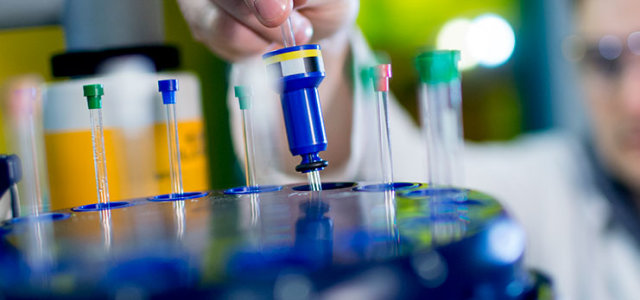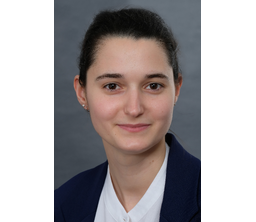Chemical and Environmental Analytics Core Facility
The first core facility to support research at TH Köln has been established on the Leverkusen campus with the DFG-funded Chemical and Environmental Analytics Core Facility (ChEAF).
In the ChEAF, instrumental analysis of low- and high-molecular organics is centralized and systematically expanded. Ambitious research projects at TH Köln in the fields of water and environmental analytics, drug research, and bioeconomy are thus driven forward in a targeted manner.
As an analytics center, the ChEAF offers a modern range of analytical equipment and methodologies with the aim of supporting interdisciplinary and interfaculty research, promoting networking among researchers, and providing impulses for new approaches to knowledge-oriented research. Qualified staff are ready to advise researchers and support them in method development, sample analysis and data evaluation.
The services offered by ChEAF are directed towards all researchers at TH Köln as well as external users, with a primary focus on the academic community. In addition to nuclear magnetic resonance spectroscopy (400 MHz NMR), a range of mass spectrometry methods (GC/LC coupling) are offered.
Avance III HD – 400 MHz NMR (Bruker)
 NMR spectrometer with autosampler
(Image: Media Lab - TH Köln)
NMR spectrometer with autosampler
(Image: Media Lab - TH Köln)
Avance III HD - 400 MHz NMR spectrometer equipped with a broadband probe head for the determination of 1H, 13C, 19F, 31P and 35Cl nuclei and autosampler (Bruker)
Application: Structure elucidation and identification of synthesis products
1D experiments: 1H, 13C, 19F, 31P, 35Cl
2D experiments: COSY, HMBC, HSQC, NOESY
LCMS-2020 (Shimadzu)
 LCMS-2020
(Image: Media Lab - TH Köln)
LCMS-2020
(Image: Media Lab - TH Köln)
Nexera UHPLC coupled with a PDA detector and a LCMS-2020 single quadrupole mass spectrometer (Shimadzu)
Ionization methods: ESI, APCI
Mass range: m/z 10 – 2,000
Resolution: Unity resolution
Maximum scan speed: 15,000 u s-1
Application: Qualitative and quantitative analysis of substances such as non-steroidal anti-inflammatory drugs (NSAIDs) in water
Exploris 240 (Thermo Fisher Scientific)
 Exploris 240 Orbitrap mass spectrometer
(Image: Media Lab - TH Köln)
Exploris 240 Orbitrap mass spectrometer
(Image: Media Lab - TH Köln)
Vanquish Flex UHPLC coupled with a PDA detector and a high-resolution Exploris 240 Orbitrap mass spectrometer (Thermo Fisher Scientific)
Ionization methods: ESI
Mass range: m/z 40 - 6,000
Resolution: up to 240,000 (FWHM) at m/z 200 (1.5 Hz scan rate)
Mass accuracy: < 1 ppm with internal calibration (EASY-IC)
Application:
- Determination of the molecular formula based on the accurate mass
- Structure elucidation via MS2 experiments
- Targeted and untargeted analysis in different matrices (e.g. per- and polyfluorinated alkyl compounds (PFAS) in sediments)
GCMS-QP2020 (Shimadzu)
 GCMS-QP2020
(Image: Media Lab - TH Köln)
GCMS-QP2020
(Image: Media Lab - TH Köln)
GC-2012 Plus gas chromatograph coupled with an FID detector and GCMS-QP2020 single quadrupole mass spectrometer (Shimadzu)
Ionization methods: EI
Mass range: m/z 1.5 - 1,090
Resolution: Unity resolution
Maximum scan speed: 20,000 u s-1
Injection principle: Split/Splitless
Application: Qualitative and quantitative analysis of substances such as polycyclic aromatic hydrocarbons (PAHs), polychlorinated biphenyls (PCBs), and volatile organic compounds (VOCs)
BenchTOF-Evolve (Markes International)
 BenchTOF-Evolve
(Image: Media Lab - TH Köln)
BenchTOF-Evolve
(Image: Media Lab - TH Köln)
7890 GC System gas chromatograph (Agilent Technologies) coupled to a BenchTOF-Evolve time-of-flight mass spectrometer with UNITY-xr thermal desorption unit (Markes International)
Ionization methods: EI
Mass range: m/z 1 - 800
Resolution: >1200 (FWHM) at m/z 100 - 800
Spectra acquisition speed: 10,000 Hz
Application: Analysis of very volatile organic compounds (VVOCs), volatile organic compounds (VOCs), and semi-volatile organic compounds (SVOCs), for example, in microplastics or for analyzing air quality.




